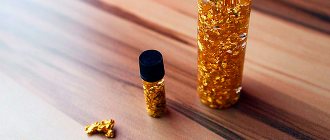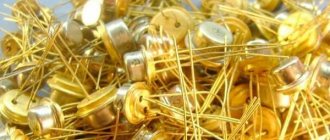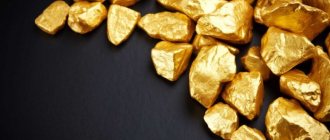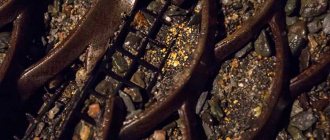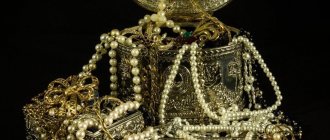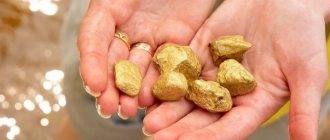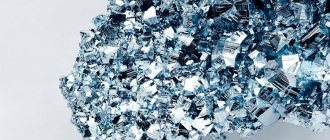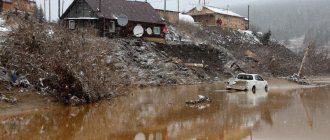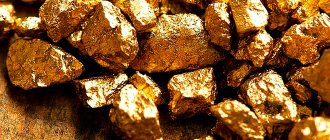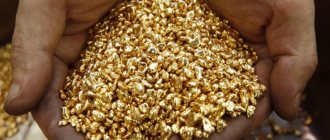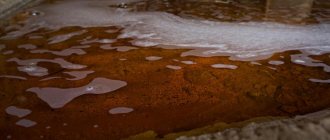The European part of Russia is not so rich in gold deposits in comparison with the Trans-Ural territories. However, for example, in the north of Karelia, the Severonickel enterprise, in addition to nickel, also produces a small amount of ore and precious metal concentrate. There are also small placers. Gold mining in the Leningrad region has been recognized as unprofitable, but this does not stop private miners who independently wash aurum in the rivers and streams of the region. Where and how to look for precious grains of yellow metal. And is it realistic to mine gold in the northwest of the country?
Is there gold in the Leningrad region
The ancient Trans-Ural mines have long since reduced their profitability. The depletion of the traditional central and northeastern territories is forcing the government to look for new ways to replenish the budget. Simultaneously with this problem, quite significant successes were discovered in the Finnish-Karelian direction. Gold was found there quite by accident, during the extraction of stone and sand for construction.
Finland is located between the 60th and 70th parallel, slightly north of St. Petersburg. Similar geological conditions give every right to talk about the presence of native gold in the Leningrad region. True, in what volumes?
Historical reference
Gold mining in Russia has been seriously developing for about 3 centuries. Over the entire period, about 17,000 tons were brought to the earth's surface. It ensured the stability of the ruble in tsarist times and helped the USSR during its post-war formation. To this day, the precious metal makes it possible to maintain authority in the international financial arena along with oil and gas.
In the 19th century, an imperial decree was issued allowing private gold mining. The miners were required to pay taxes on what they found. This contributed to the development of the gold rush.
Its scale was no less than that of the famous one in Alaska or California. The bulk of the production took place in the territory of Siberia and the Urals, but the Leningrad region was also not spared. Gold was panned by hand in the most primitive way.
First major finds
There is a documented case of Emperor Alexander I personally finding a 0.3 kg nugget in 1842. This happened at the Ladoga mines. After 20 years, a huge nugget was discovered, weighing more than 0.5 kg. It received the proud name Peterhof.
Panning for gold along large rivers and streams was a common practice. During the construction of water mills, teams of prospectors worked to look for deposited metal on the blades of the mechanisms.
The hidden wealth of Novaya Ladoga
If in Staraya Ladoga, in order to discover an ancient artifact, many years of scientific research, large-scale excavations and painstaking work of an entire army of archaeologists are needed, then in Novaya Ladoga the treasures lie, as they say, right under your feet in the beach sand. Only no one notices them...
One day, while walking with friends along the shore of Lake Ladoga, at the very mouth of the Volkhov, we found an unremarkable flat stone, similar to granite, and wanted to throw it into the water. But when we turned it over, we found in it a peculiar blue cut with beautiful stripes that shimmered in the sun with all the colors of the rainbow. It was a small inclusion in the stone: a kind of stone within a stone. Looking at him, someone said: there are plenty of such stones on any road, throw him away. And we threw it away. But in vain! It was a type of moonstone, scientifically called spectrolite!
The legend tells... However, we owe this name to Finland. In our country, the stone is more often called labradorite or in English transcription labradorite (not to be confused with the labradorite rock) - after the peninsula in North America where it was first discovered (1770) by Europeans among the Eskimos. Legend says that once the mountains of the Labrador Peninsula in eastern Canada admired the special beauty of the northern lights. On that beautiful day, a brave warrior struck the rock with his sword and struck hundreds of small particles along with sparks, which in the air received the light of the northern lights. However, not all the pieces of stone flew out. Some of them remained in the rock, giving Labradorite its unique light with a bright imprint of the northern lights. Since then, the stone cannot be confused with any other mineral. It is also called “peacock” or “tausin” stone (from the Persian word tausi - peacock). In the old days, in Staraya Ladoga, the ancient capital of Rus', tausin color with the tint of a peacock feather was considered the most elegant and luxurious. At that time, clothes were expensive, and such clothes were especially expensive, considering that the fabrics for sewing them were delivered to Russia from Byzantium and Persia along the great route “from the Varangians to the Greeks,” which passed, among other things, along the Volkhov River.
Properties of the stone The best representatives of Labradorite have iridescence (an optical effect in the form of a rainbow-colored glow), reminiscent of the shimmer of a “cat’s eye” (stones from Greenland) or a “peacock feather” (India, Madagascar). Less vibrant varieties are found in Germany and Finland. Australian Labradors are very famous, used as semi-precious stones in jewelry. Labradorite or spectrolite is a mineral from the feldspar group; more simply, it is a rock, crystalline, mostly medium-grained, light gray, dark gray, dark blue, almost black. It was used as a facing stone back in Kievan Rus, and later it was readily used for finishing monumental buildings. The pedestal of the monument to Alexander III, which once stood on Znamenskaya Square in St. Petersburg (now Vosstaniya Square) also had inclusions of labradorite. The beauty of the stone is created by the ability of some crystals to reveal blue, blue, sometimes golden or green iridescence. It was called spectrolite because absolutely all the colors of the solar spectrum and their derivatives appear in it; has a blue sheen, which is the most common, and also has several metallic shades. That is why the Finnish professor Aarne Laitakari (1890-1975), a specialist in the field of mineralogy and a passionate lover of stones and ancient fossils, gave it the name spectrolite, which later became a trademark of a Finnish jewelry company. What causes sensational interest in the stone has not yet been scientifically proven, but it is believed that it is light waves that play a major role in the thin layers of the mineral where reflection and refraction of light occurs.
Journey to the mouth of the Volkhov During an expedition to the southern shore of Lake Ladoga in the 1890s. German professor Max Bauer (1844-1917) discovered stone blocks with labradorite crystals in the area between Shlisselburg and Novaya Ladoga and proved that the stone got there with continental ice during the Ice Age. In his work, Bauer, among other things, provides an interesting detail. A Parisian jeweler named LeCaire possessed a rare stone, believed to be Australian, but it was one of the first minerals mined in Russia - Russian labradorite, and what a one! Its value lay in the fact that the texture of the stone was a kind of natural medallion - an exact copy of the head of Louis XVI, executed during the French Revolution. The azure head of the king, decorated with a stylized crown of ruby-garnet hue, was located on a golden-green background and was framed by an edging that shimmered with all the colors of the rainbow. This natural composition is gracefully complemented by a small silver-metallic plume. The jeweler valued the rare Russian Labrador at 250,000 francs, which at the exchange rate of 1799 represented a fortune. Apparently, traces of the unusual stone lead to the outskirts of St. Petersburg, where in 1781 large boulders with labradorite were found during the construction of the road to Peterhof. Jewelers quickly took advantage of the new product, and soon the capital's aristocracy began to wear rings, rings, earrings and pendants with this stone, which was considered a fashionable and expensive decoration. It was from the Russian capital that the jeweler Loecker brought a hitherto unprecedented curiosity to Paris. Professor Laitakari studied the mineralogy of his colleague Bauer and believed that the “mother plate” must have been located somewhere in Eastern Finland. Back in the 1930s, the scientist and his son explored these places in search of beautiful blue stones - but it was all in vain. Time passed. The search continued. And in 1941, quite by accident, young Pekka Laitakari (son of a professor), who served in an engineering battalion, discovered labradorite crystals in stones used as a binding material in anti-tank gouges and concrete pillboxes on the Salpa line. This line of fortifications is not as famous as the Mannerheim line, but its strategic importance at that time was great. The line was a grandiose structure - a 1,200 km long network of fortification barriers stretched from south to north along the border from the Gulf of Finland to the city of Petsamo in Finland with powerful pillboxes, bunkers, anti-tank gouges, trenches, spherical bunkers and barbed wire. The line was built in 1941, after the “Winter War” of 1939-40, to protect against a possible attack from the Soviet Union. It did not participate in hostilities, although it was significantly more powerful than Mannerheim’s line. It was during the construction of this system of fortifications that the son of Professor Laitakari asked the engineers where the stones for anti-tank gouges and pillboxes were brought from and, having learned the place of shipment, triumphantly wrote to his father that the source of the mineral was quarries in the area of Ylämaa in Southern Finland. The professor’s conclusions were confirmed. Unfortunately, during the war, Pekka Laitakari (1920-1941) died in battle, but his memory lives on, and Finnish jewelers remember him every time they insert another spectrolite of exceptional beauty into a frame. Now the Mineral Museum in Ylämaa has a collection of 5,000 stones from all over the world. Semi-precious stones, fossils and even meteorites are stored there. There is also a small quarry where you can take your favorite spectrolite as a souvenir. By the way, various parts of crystals can be iridescent: the outer rim, individual sections or parallel stripes. In addition, when the angle of view changes, some crystals darken, stop iridescent, and others shimmer with bright light, already in new places. Blue, blue or golden “lights”, similar to fireflies, especially against a dark background of the rock, look very impressive and give the stone an extraordinary charm.
Amulet, amulet and healer Let's listen to what the researchers of this stone and astrologers say. Labradorite is a type of moonstone. In ancient times, it was believed that it rewarded the owner with the gift of an orator, intuition, and the unique ability to predict the future and make the right decisions in difficult situations. Spectrolit, like other Labradors, develops internal vision in its owner, reveals extrasensory abilities, and awakens hidden talents. Stones differ by gender - lighter ones are considered female stones, dark ones, with a green or brown tint, are considered male stones. It is good when a person has two stones of different genders. The pair of minerals attracts marital happiness to its owner, gives him the ability to be attentive to his “other half”, and helps to competently and efficiently run the household. Labradorite is believed to be effective against thieves. By placing a stone on the threshold, you can protect your home from uninvited guests. We can say that Labradorite is a protective stone. In addition, the stone helps to cure infertility and impotence, and is effective for diseases of the genitourinary system and prostate gland. The mineral is used by healers to relieve pain in the spine and joints, and to prevent diseases of the ear, throat, nose and lungs. Pendants, pendants, earrings and rings with Labradorite help improve mood, alleviate the effects of stressful situations, improve sleep and help with insomnia. Astrologers believe that Labradorite can be worn by all zodiac signs without exception, but the stone most actively helps Aries and Virgos. Spectrolite is used to make beautiful cabochons, pendants and beads. However, Labrador should not be given into the hands of others, since the touch of strangers destroys the power of the talisman. Labradorite draws strength from the Black Moon, so it needs to be activated on every full moon, when the Moon is best visible. Labrador is a useful companion during times of change, imparting strength and perseverance. This is a mineral of transformation, it prepares the body and soul for further development.
Louhi - Mistress of the North In the 20th century, the Finnish writer Elsa Heporauta (1883-1960) had a dream to build a monument to a woman - the epic patroness of Finland. She appealed to all the ladies with a request to organize a fundraiser for the monument. Many people responded to her call, and enterprising Finns decided to make copies of Viking jewelry taken from the National Museum with the aim of selling them to the general public. And it worked! (To be continued)
Alexey and Nikita Zotov
Tell this news to your friends:
Geographic location and landscape features
It is customary to look for gold in places of massive occurrence of igneous rocks. In geography, this term is called crystalline shields. Part of the crystalline Baltic shield is located on the territory of the Leningrad region. Most of the formation is occupied by the Karelian Isthmus.
The origin of the isthmus coincides with the active phase of the Ice Age. At this time, blocks of ice moved and mixed rocks on the surface of the earth's crust. This contributed to the massive deposition of heavy metal on the surface.
Where to look
Deposits of gold, like any metal, are in most cases located in places where igneous rocks occur. That is, where millions of years ago molten magma came close to the surface of the planet. These places occupy vast territories, and in geography they are called crystalline shields.
The second and richest in various ore deposits are the mountain-building zones. Here, for millions of years, processes of compression and mixing of the rocks that make up the earth's crust took place. All this was accompanied by significant volcanic activity. It is in such areas that native copper and gold are often found.
But if the Leningrad region does not differ in mountain formation, then part of the crystalline shield, which has the name Baltic, does exist.
Half of the Karelian Isthmus is occupied by this tectonic formation. And this is where you need to look for gold.
Another process took part in the origin of gold on the Karelian Isthmus - the Ice Age. Each glacier necessarily moves, working like a huge bulldozer, raking up all the rocks it encounters along the way. After melting, it left tons of rock, the deposits of which may contain gold grains.
However, for profitable extraction of precious metal ore, significant volumes must be present. It should also contain at least 3 grams of aurum per ton of rock. In this case, the deposit is considered suitable for development. So far, no such deposits have been discovered in the region.
In most cases, gold in the region is found along the shores of the Gulf of Finland and Lake Ladoga, as well as streams and rivers. That is, where water has eroded rocks into small particles. In such places, grains of sand nuggets of gold are found.
It was along the shores of Ladoga that they washed the rock in search of precious yellow grains. Today, on an industrial scale, this is considered unprofitable. To do this, one cubic meter of rock should contain 100-200 mg of metal. But this is not an indicator for private prospectors, and there are cases of isolated finds in the region.
What mineral resources are there in the Leningrad region
Sand and gravel rocks are massively mined in the region. It was in such conditions that the Finns found gold placers. The mass fraction of metal here is quite low. When developing deposits of construction sand, they try to find out the level of profitability of the accompanying gold mining.
Geological surveys and massive soil sampling in the area of the Shokshi and Oyat rivers showed the presence of kimberlite pipes, which indicates the deep occurrence of diamonds. True, the breed is quite small and is not suitable as precious stones for jewelry.
The presence of hydrocarbons indicates the presence of oil reservoirs. The main problem remains the cost of producing a barrel.
The main natural resources that are massively mined in the region include clay, sand, limestone, shale, phosphorites, and bauxite. The rock is mined primarily using the mining method. More than 2,000 peat bogs provide continuous peat extraction.
Gold mining in Russian regions
First of all, these are regions of the Far East. In the course of the work, the task of identifying the placer gold content of glacial deposits within existing quarries mining deposits of sand and gravel materials and construction sands was solved.
This is due to the fact that mineralogical studies have so far been mainly carried out to solve general geological problems, which did not require a complete mineralogical analysis. In general, the results of mineralogical studies in the work area are fragmentary and scattered, which significantly complicates their comparison.
Main gold deposits in the Leningrad region
The meager location of gold in the Leningrad region forces us to recognize metal mining on an industrial scale as unprofitable at the current level of development.
By whom, how and where it is mined
Private prospectors and enthusiasts search for and pan for gold in time-tested places:
- in the old mines of the times of Tsarist Russia. Coordinates are found by studying archival sources;
- near ancient water stairs and dam structures. Heavy metal settles well in hard-to-reach places;
- behind large boulders in the rapids of a fast river.
Hobbyists use two types of equipment: primitive metal washing tools and modern sound detectors. All-terrain vehicles allow you to move around an area with comfort and high speed. The luckiest miners find fairly decent amounts of sand.
